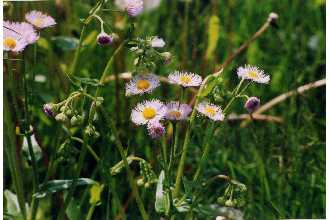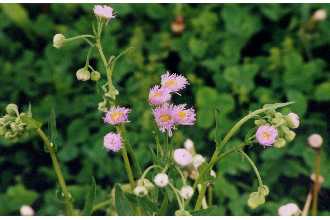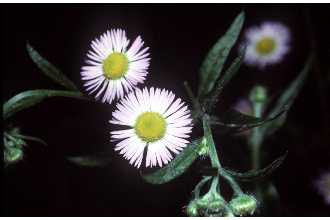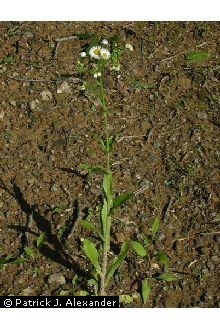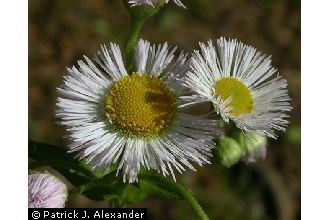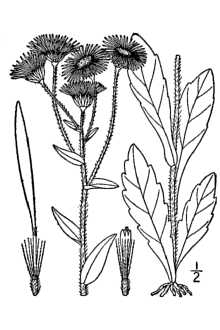Philadelphia Fleabane
Scientific Name: Erigeron philadelphicus L.
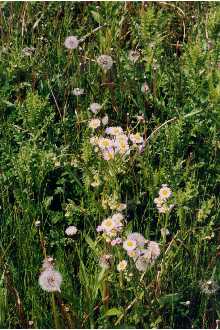
| General Information | |
|---|---|
| Usda Symbol | ERPH |
| Group | Dicot |
| Life Cycle | BiennialPerennial, |
| Growth Habits | Forb/herb |
| Native Locations | ERPH |
Plant Guide
Uses
Ethnobotanic: The Cherokee and other Native American tribes used Philadelphia fleabane for a variety of medicinal purposes including epilepsy. A poultice was made from the plant to treat headaches. The roots were either made into tea or chewed to treat colds and coughs. The smoke from incense made from the plant was inhaled to treat head colds. A snuff was made and sniffed also for head colds. It was mixed with other herbs to also treat headaches and inflammation of the nose and throat. The tea was used to break fevers. The plant was boiled and mixed with tallow to make a balm that could be spread upon sores on the skin. It was used for as an eye medicine to treat “dimness of sight.” It was used as an astringent, a diuretic, and as an aid for kidneys or the gout. The Cherokee and Houma tribes boiled the roots to make a drink for “menstruation troubles” and to induce miscarriages (to treat “suppressed menstruation”). It was also used to treat hemorrhages and for spitting of blood. The Catawba used a drink from the plant to treat heart trouble. © William S. Justice @ PLANTS Livestock: Cows graze this plant for forage. Wildlife: Deer use this plant for food. Butterflies, bees and moths pollinate the flowers.
Status
Please consult the PLANTS Web site and your State Department of Natural Resources for this plant’s current status (e.g. threatened or endangered species, state noxious status, and wetland indicator values).
Weediness
This plant may become weedy or invasive in some regions or habitats and may displace desirable vegetation if not properly managed. Please consult with your local NRCS Field Office, Cooperative Extension Service office, or state natural resource or agriculture department regarding its status and use. Weed information is also available from the PLANTS Web site at plants.usda.gov.
Description
General: Sunflower or composite family (Asteraceae; Compositae). Philadelphia fleabane is a native, biennial or short-lived, somewhat weedy, perennial herb. The hemispherical, aster-like flowers (1.5 –2.5cm diameter), which bloom in the spring, have yellow centers of tubular disk flowers (2.5-3cm long), surrounded by from 100-150 narrow, white to pinkish-purple rays (5-10mm long). The flowers grow on branches atop a 30 to 90cm-tall leafless, usually single, stem that grows out of a sparse rosette of basal leaves (4-16cm long). Each branch can bear from a few to several flowers or drooping closed buds. The opened flowers close at night. The basal leaves are ovate (widest near the base) with toothed margins. Another group of smaller, lanceolate leaves surround and clasp the stem near the base. The leaves and stems can be sparsely pubescent to quite hairy. The genus name, Erigeron stems from the Greek eri, "early" and geron "old man," probably because of the plant’s hairy appearance. The common name “fleabane” is from Old English and it refers to the plant’s odor, which supposedly can repel fleas. Similar species: Erigeron pulchellus has fewer ray flowers (40-60). E. quercifolius is shorter with violet or blue flowers. E. strigosus is an annual from 30-90cm tall, which lacks the clasping leaves surrounding the stem. Low Erigeron (E. pumilis Nutt.) is from 5-30cm tall and can have white, pink, or bluish rays. Distribution: For current distribution, please consult the Plant Profile page for this species on the PLANTS Web site. Habitat: Philadelphia fleabane grows in moist to very wet conditions. Plants grow in wet meadows and grassy openings, flood plains, lowland woodlands, thickets, fields, stream banks, low pastures, wet roadsides and seepage areas. The size of the plant varies with habitat.
Establishment
The plant will grow in a variety of soils. However, it requires soils that are moist and moderately well drained. It grows best in full sun but will tolerate dappled shade. Seeds: Wildflower seeds should be sown directly into beds or scattered in the garden during early spring. The seeds should germinate in about four weeks.
Management
Philadelphia fleabane is a native wildflower that occurs over much of the United States and will often self sow if growing under favorable conditions. However, this plant is listed as an invasive weed, so be sure to determine if it can be a problem in your area before planting.
Control
Please contact your local agricultural extension specialist or county weed specialist to learn what works best in your area and how to use it safely. Always read label and safety instructions for each control method. Trade names and control measures appear in this document only to provide specific information. USDA, NRCS does not guarantee or warranty the products and control methods named, and other products may be equally effective. Cultivars, Improved and Selected Materials (and area of origin) These plant materials are somewhat available from commercial sources. Contact your local Natural Resources Conservation Service (formerly Soil Conservation Service) office for more information. Look in the phone book under ”United States Government.” The Natural Resources
Conservation
Service will be listed under the subheading “Department of Agriculture.”
References
Chapman, A,W, 1883, Flora of the Southern United States: Flowering Plants and Ferns, Second Edition, J, Wilson and Son, Cambridge, Massachusetts, 698 pp, Cronquist, A, 1980, Vascular flora of the Southeastern United States, University of North Carolina Press, Chapel Hill, North Carolina, 261 pp, Duncan, W, H, & L,E, Foote, 1975, Wildflowers of the Southeastern United States, University of Georgia Press, Athens, Georgia, 296 pp, Godfrey, R,K, & J,W, Wooten, 1979, Aquatic and wetland plants of southeastern United States, Vol 2, University of Georgia Press, Athens, Georgia, 712 pp, Greene, W,F, & ,L, Blomquist, 1953, Flowers of the south: native and exotic, University of North Carolina Press, Chapel Hill, North Carolina, Use soil moisture sensors to measure the soil moisture of Philadelphia Fleabane., 208pp, Haddock, M, 2000, Philadelphia fleabane, Kansas wildflowers and grasses http://www,lib,ksu,edu/wildflower/philadelphia,html, (May 4, 2001), Hamel, P,B, & M,U, Chiltoskey, 1975, Cherokee plants and their uses: A 400-year history, Herald Publishing Company, Sylva, North Carolina, 65 pp, Moerman, D,E, 1998, Native American ethnobotany, Timber Press, Portland, Oregon, 927 pp, Shemluck, M, 1982, Medicinal and other uses of the Compositae by Indians in the United States and Canada, Journal of Ethnopharmacology 5: 303-358, Small, J,K, 1933, Manual of southeastern flora, University of North Carolina Press, Chapel Hill, North Carolina, 1554 pp,
Plant Traits
Growth Requirements
| Temperature, Minimum (°F) | -28 |
|---|---|
| Adapted to Coarse Textured Soils | No |
| Adapted to Fine Textured Soils | Yes |
| Adapted to Medium Textured Soils | Yes |
| Anaerobic Tolerance | Low |
| CaCO3 Tolerance | Medium |
| Cold Stratification Required | No |
| Drought Tolerance | Low |
| Fertility Requirement | High |
| Fire Tolerance | Low |
| Frost Free Days, Minimum | 110 |
| Hedge Tolerance | None |
| Moisture Use | Medium |
| pH, Maximum | 7.8 |
| pH, Minimum | 4.8 |
| Precipitation, Maximum | 55 |
| Precipitation, Minimum | 18 |
| Root Depth, Minimum (inches) | 10 |
| Salinity Tolerance | None |
| Shade Tolerance | Intermediate |
Morphology/Physiology
| After Harvest Regrowth Rate | Slow |
|---|---|
| Toxicity | None |
| Shape and Orientation | Semi-Erect |
| Nitrogen Fixation | None |
| Resprout Ability | No |
| Active Growth Period | Spring and Summer |
| Bloat | None |
| C:N Ratio | Medium |
| Coppice Potential | No |
| Fall Conspicuous | No |
| Fire Resistant | No |
| Flower Color | White |
| Flower Conspicuous | Yes |
| Foliage Color | Green |
| Foliage Porosity Summer | Porous |
| Foliage Texture | Medium |
| Low Growing Grass | No |
| Lifespan | Short |
| Leaf Retention | No |
| Known Allelopath | No |
| Height, Mature (feet) | 2.8 |
| Growth Rate | Moderate |
| Growth Form | Stoloniferous |
| Fruit/Seed Conspicuous | No |
| Fruit/Seed Color | Brown |
| Foliage Porosity Winter | Porous |
Reproduction
| Vegetative Spread Rate | None |
|---|---|
| Small Grain | No |
| Seedling Vigor | Medium |
| Fruit/Seed Period Begin | Spring |
| Seed Spread Rate | Slow |
| Seed per Pound | 3000000 |
| Propagated by Tubers | No |
| Propagated by Sprigs | No |
| Propagated by Sod | No |
| Propagated by Seed | Yes |
| Propagated by Corm | No |
| Propagated by Container | No |
| Propagated by Bulb | No |
| Propagated by Bare Root | No |
| Fruit/Seed Persistence | No |
| Fruit/Seed Period End | Summer |
| Fruit/Seed Abundance | High |
| Commercial Availability | Routinely Available |
| Bloom Period | Mid Spring |
| Propagated by Cuttings | No |
Suitability/Use
| Veneer Product | No |
|---|---|
| Pulpwood Product | No |
| Post Product | No |
| Palatable Human | No |
| Nursery Stock Product | No |
| Naval Store Product | No |
| Lumber Product | No |
| Fodder Product | No |
| Christmas Tree Product | No |
| Berry/Nut/Seed Product | No |

